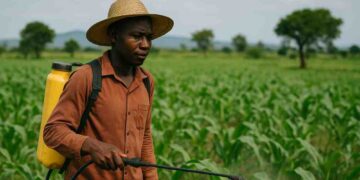Nationwide Pesticide Crackdown Prioritizes Public Health and Environmental Safety
Nairobi, May 2025 — Kenya’s Ministry of Agriculture and Livestock Development has announced a forthcoming ban on over 50 toxic pesticide products, including well-known agrochemicals such as Mancozeb, Paraquat, Glyphosate, and Carbendazim. This move aligns Kenya with international standards aimed at curbing the use of highly hazardous pesticides (HHPs).
The announcement was made on May 7 by Cabinet Secretary Hon. Mutahi Kagwe, following renewed legislative scrutiny and rising public concern over pesticide safety.
Regulatory Shift Rooted in Parliamentary Review
In April 2025, Kenya’s National Assembly’s Committee on Implementation revisited a 2019 petition that called for phasing out pesticides linked to severe health and ecological risks. The committee criticized past inaction and emphasized the urgent need for regulatory reform, particularly as evidence mounts linking certain pesticides to cancer, reproductive issues, and environmental degradation.
Targeted Substances: A List of Global Concern
While the specific 50 products have not yet been disclosed, advocacy groups have identified a number of HHPs in current circulation likely to be included:
- Mancozeb – fungicide banned in the EU, linked to endocrine disruption.
- Paraquat – highly toxic herbicide bannedLimin Group Increases Fungicide Prices Amid Rising Costs and Strong Market Demand in over 60 countries.
- Glyphosate – under international scrutiny for potential carcinogenicity.
- Carbendazim – associated with reproductive harm.
- Lambda-cyhalothrin, Cypermethrin, and Deltamethrin – synthetic pyrethroids with documented neurotoxicity and persistence.
Civil Society Demands Transparency
Farmer associations and civil society groups have urged the government to release the full list of banned substances and communicate a clear timeline for enforcement. The Route to Food Initiative (RTFI) and similar organizations are also advocating for stronger farmer support systems to transition to integrated pest management (IPM) and biopesticide alternatives.
Chinese and Multinational Stakeholders: Market Disruption Anticipated
Kenya currently holds more than 2,000 pesticide registrations across 491 companies. Notably:
- ~50% of registrations are Chinese-held, including:
- Ningbo Sunjoy Agroscience Ltd.
- Sinochem Ningbo Chemicals Co. Ltd.
- Jiangsu CF Agrochemicals Co. Ltd.
- Key multinational players with affected portfolios:
- Syngenta
- Corteva
- Bayer
- BASF
The ban will significantly impact these producers, particularly those exporting restricted compounds. China, India, and Germany are among the top exporters of the soon-to-be-banned pesticides into Kenya. Major importers of these pesticides globally include Brazil, the United States, and several African nations with large-scale monoculture farming systems.
Export Perspective: Global Distribution of Targeted Pesticides
- Mancozeb is widely exported from India and China, primarily to Africa and Latin America.
- Glyphosate exports are led by China, the U.S., and Argentina.
- Paraquat is still manufactured in parts of Asia despite bans in Europe.
- Carbendazim is mostly exported by China and India.
This Kenyan ban could influence broader African regulatory patterns and reshape sourcing for regional agriculture.
What’s Next: Enforcing the Ban and Supporting Alternatives
The Ministry has not yet released enforcement guidelines, but experts anticipate a phased withdrawal period alongside public-private initiatives to promote low-toxicity alternatives such as:
- Biological controls
- Biopesticides
- Traditional pest deterrents
For these initiatives to succeed, the government must provide financial and technical support to smallholder farmers most affected by the regulation.
Conclusion
Kenya’s decision to ban over 50 toxic pesticides represents a critical step toward aligning its agricultural practices with international safety standards. While the ban is welcome news for health and environmental advocates, its successful implementation hinges on transparency, enforcement, and farmer support mechanisms.












